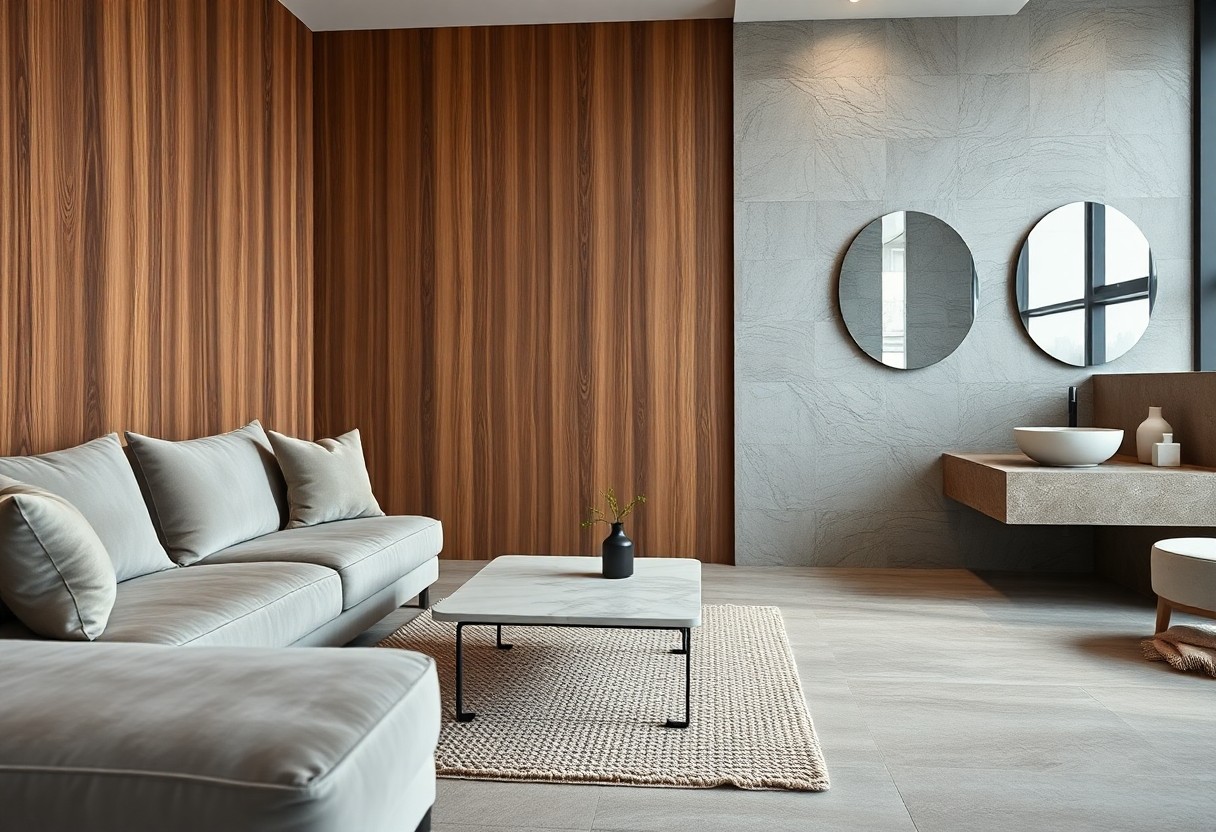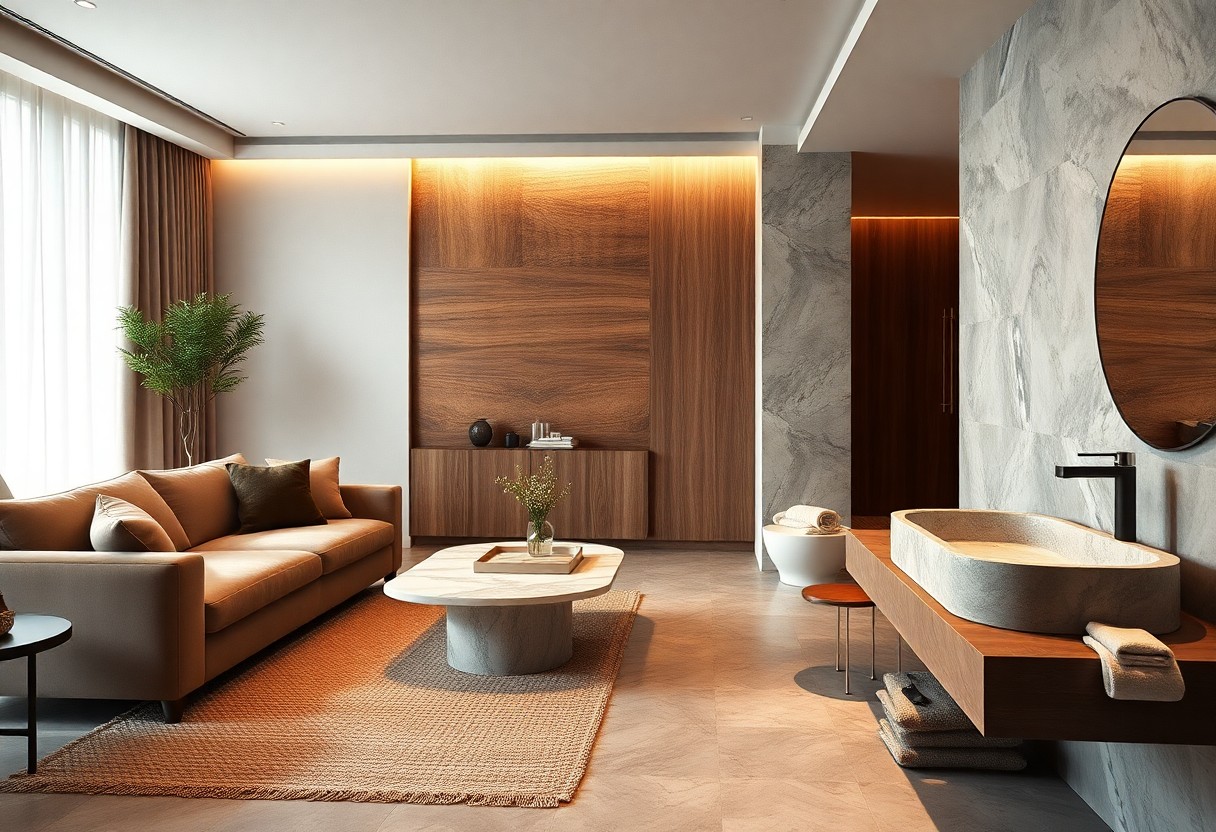How Can Layering Textures In Bathrooms And Living Rooms Create A Captivating Contrast?

Many homeowners seek ways to elevate the aesthetic of their spaces, and one powerful method is layering textures in your bathrooms and living rooms. By combining various materials such as smooth ceramics, soft fabrics, and rugged wood, you can create a dynamic interplay that adds depth and interest to your environment. This approach not only enhances visual appeal but also contributes to the overall tactile experience of your living spaces. Join us as we explore the art of texture layering and how it can transform your home into a captivating sanctuary.
Understanding Texture in Interior Design
A harmonious blend of textures can elevate your interior design, enhancing the visual appeal of any space. By incorporating various materials, you can create depth and dimension that draws the eye, making rooms more inviting and interesting. Understanding texture allows you to play with contrasts and cohesiveness in design, giving you the tools to curate a unique atmosphere tailored to your personal style.
Definition and Importance of Texture
Texture refers to the surface quality of materials, whether they are smooth, rough, soft, or hard. It plays a vital role in interior design as it influences how a space feels; it can evoke emotions and enhance sensory experiences, making your surroundings more enjoyable. By thoughtfully integrating textures, you can transform the ambiance of your home.
Different Types of Textures
There are several types of textures you can incorporate in your interiors, each offering a different aesthetic and tactile quality. Consider using elements that possess:
- Soft textures like velvet and chenille
- Natural textures such as wood and stone
- Hard textures like metal and glass
- Patterned textures such as woven fabrics
- Matte versus glossy finishes
This diverse palette of textures can create engaging contrasts within your spaces.
| Texture Type | Characteristics |
| Soft | Cozy, inviting feel |
| Natural | Organic and earthy appearance |
| Hard | Modern and sleek aesthetic |
| Patterned | Adds visual interest and depth |
| Matte vs Glossy | Creates visual contrast and dynamic appeal |
More About Different Types of Textures
For instance, utilizing soft textures like cushions and rugs can introduce comfort to your living space., while hard textures can deliver a contemporary edge. The combination of these textures enhances your environment by providing contrast, leading to a more complex and well-rounded design. You can also explore combinations of natural materials with synthetic ones for added intrigue:
- Layering textiles for visual depth
- Mixing smooth surfaces with rough ones
- Incorporating botanical elements for organic texture
- Utilizing different fabric weaves for nuanced effects
- Experimenting with reflective surfaces to amplify light
This thoughtful layering can significantly amplify the overall appeal of your spaces.
| Texture Combination | Effect |
| Textiles and Metals | Creates a modern contrast |
| Wood and Glass | Offers warmth and elegance |
| Soft Fabrics and Hard Flooring | Enhances comfort and stability |
| Plants and Synthetic Decor | Adds life and vibrancy |
| Warm and Cool Tones | Balances warmth and freshness |
The Role of Color in Texturing
Some may overlook how color contributes significantly to the texture in your spaces. The right hues can amplify or soften the impact of different materials, bringing your design vision to life. For insightful strategies on enhancing your home’s appeal, check out Top Tips to Transform Your Home with Texture.
Color Theory and Texture Interaction
Texturing your space without considering color can lead to a disjointed aesthetic. When you apply color theory, you’ll find that warm tones can make a texture feel inviting, whereas cool colors may lend a serene, crisp touch. By thoughtfully coordinating colors, you enhance the perception of depth and warmth in your rooms.
Creating Contrast with Color
Interaction between contrasting colors and textures adds dynamism to your design. Utilizing a mix of light and dark shades can emphasize the three-dimensionality of materials, making even subtle textures pop. This method allows you to differentiate surfaces, guiding the eye and creating focal points in your living or bathroom spaces.
But this contrast should be balanced to ensure your space remains harmonious. You can experiment by pairing rough textures, like a stone wall, with smooth, glossy surfaces in a stark color palette. This juxtaposition not only enhances each element but also creates a visually stunning experience, drawing guests in and making your rooms genuinely captivating.

Layering Textures in Bathrooms
Clearly, layering textures in bathrooms can elevate the overall aesthetic while ensuring that the space feels livable and warm. By integrating various materials, colors, and patterns, you can transform a sterile environment into a sanctuary. From soft, plush towels to sleek ceramic tiles, the combination of different textures not only adds visual interest but also enhances the sensory experience in your bathroom.
Combining Materials for Depth
Textures play a vital role in creating depth and dimension. Consider mixing materials like wood, stone, and glass to create an engaging visual contrast. The warmth of wooden elements can soften cold surfaces, while reflective glass can enhance light and space, making your bathroom feel both inviting and luxurious.
Practical Tips for Texture Layering
To effectively layer textures in your bathroom, consider the following tips:
- Choose a cohesive color palette to unify different textures.
- Incorporate various materials such as fabrics, metals, and ceramics.
- Use rugs, towels, and accessories to introduce softness.
The result will be a harmonious space that feels well-designed and personalized.
A few additional suggestions can help you further enhance texture layering in your bathroom:
- Experiment with different patterns and prints to create interest.
- Balance heavy textures with lighter ones to avoid overwhelming the space.
- Consider using plants or greenery for a natural texture boost.
The right combinations will ensure your bathroom reflects your style while being functional.
Layering Textures in Living Rooms
Many homeowners strive to create an inviting living room by layering textures that evoke warmth and excitement. Mixing textiles like plush rugs, soft throws, and a variety of cushions can enhance the visual appeal while providing comfort. For guidance on achieving a vibrant aesthetic, check out this article on Maximalist Interior Design: How to Layer Patterns and Textures.
Balancing Comfort and Style
Below the surface of your living room’s aesthetic lies the need to balance comfort and style. Combining luxe materials with more laid-back elements can create a harmonious space where you and your guests feel at ease while enjoying a visually stimulating environment.
Key Textural Combinations
Comfort is enhanced through strategic textural combinations that engage the senses. Consider pairing a sleek leather sofa with a chunky knit throw, or juxtaposing a glass coffee table with a woven rug. These contrasts not only add depth to your decor but also keep the atmosphere inviting.
The key textural combinations can transform your living room into a captivating sanctuary. Mixing hard surfaces like wood and metal with soft textiles introduces a dynamic contrast, while layering natural materials—such as velvet, cotton, and linen—fosters an inviting ambiance. Your choice of textures can significantly influence the overall feel of the space, making it a true reflection of your personal style.
The Impact of Lighting on Textures
Once again, the interplay of lighting plays a significant role in enhancing textures within your spaces. Proper lighting can accentuate the unique qualities of various materials, helping to create a captivating contrast. For more insights on achieving this effect, check out How To Design a High Contrast Bathroom: Texture, Color …. The right combinations can completely transform your bathroom and living room aesthetics.
Natural vs. Artificial Lighting
With both natural and artificial lighting, you can manipulate how textures appear in your spaces. Natural light offers a soft, diffused effect that highlights textures beautifully as it shifts throughout the day. In contrast, artificial lighting allows you to direct and focus on specific areas, creating stunning shadows and depth that reveal your materials’ intricate details.
Enhancing Textures with Light
Natural light is your best ally when it comes to enhancing textures. By allowing sunlight to filter into your rooms, the unique contours and finishes of your surfaces come alive. This effect emphasizes the beauty of materials like wood, stone, and fabric, inviting warmth and character into your space.
And by layering different light sources, you can create a dynamic atmosphere that accentuates various textures in your design. Utilize a mix of soft ambient lighting and sharper task lights to draw attention to specific areas. This playful engagement with light enhances visual interest and invites deeper exploration of your curated spaces, making each texture a focal point in itself.
Common Mistakes to Avoid
To create a harmonious and captivating space, you must steer clear of common pitfalls in texture layering. One common mistake is overloading the design with excessive textures, colors, or patterns that clash, making your rooms feel chaotic. Strive for a balance that enhances your aesthetic vision without overwhelming it.
Overwhelming the Space
For a successful layered look, ensure that you don’t overwhelm the space with too many conflicting textures. This can create a cluttered effect that detracts from the intended ambiance. Instead, aim for a cohesive blend that highlights the best features of your design.
Ignoring Scale and Proportions
For effective texture layering, it’s important that you pay attention to scale and proportions. Using items that are mismatched in size can throw off the visual balance of your space, leading to an awkward atmosphere that doesn’t feel inviting.
Due to improper attention to scale and proportions, you might end up with oversized furniture clashing with smaller decor elements, or vice versa. This imbalance can create discomfort and detract from your overall design intent. Always consider the size of your textures and furnishings to ensure they coexist harmoniously within the space, contributing to a well-styled, inviting environment.
Summing up
Upon reflecting, you can see how layering textures in bathrooms and living rooms not only enhances the visual appeal but also creates a dynamic atmosphere. By combining materials such as smooth tiles with plush fabrics or rustic woods with sleek metals, you effectively draw the eye and evoke emotion. This contrast enriches your spaces and makes them feel warmer and more inviting. Embracing this strategy allows you to express your unique style while maintaining a cohesive flow throughout your home.












